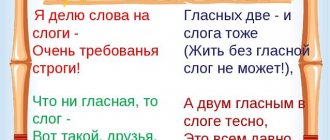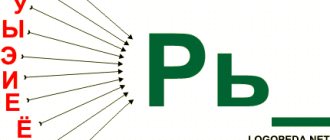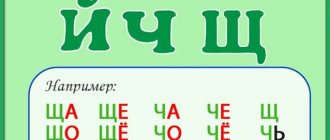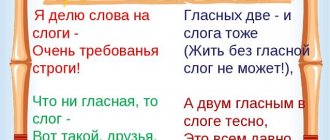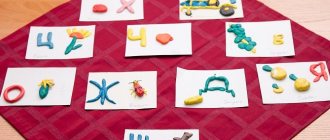Before learning to read, a child must learn the very concept of syllables. Before learning to read and write, your child must recognize letters and be able to relate them to sounds. The next stage is learning syllables. Interesting manuals for studying syllables can be downloaded from our website.
Is it difficult to teach a child to combine letters into syllables?
How to learn to read?
At the beginning of learning to read, it is necessary to convey to the child such concepts as vowel and consonant sounds and letters. Vowel sounds can be stressed or unstressed. Among the consonants, there are voiced and voiceless, hard and soft.
By the way, special attention should be paid to the hardness and softness of sounds. This characteristic of sounds within a syllable is determined by soft or hard signs or vowels located after consonants.
So, the letters E, E, I, Yu, I indicate the softness of the previous consonant sound, and the letters E, O, U, Y indicate hardness.
A table of all syllables on our website will help illustrate soft and hard consonant sounds. It can be read online or downloaded and printed from our website.
Syllables for children to learn to read can be presented in the form of a game. To teach your child to read, you need to download a table of syllables and print it. Then cut into individual cards. To prevent syllables and cards from becoming wrinkled, they can be glued onto thick cardboard. Now we will try to introduce syllable combinations to children in the form of a game.
How to speed up the process of improving reading skills
Syllable tables for preschool children have different variations - from simple to complex. It is important to monitor how the material is being absorbed and to avoid gaps in knowledge; it may take twice as long to learn a single letter or syllable, but the skill needs to be consolidated.
You need to work not only with tables, you can select short phrases and stories so that the child understands that words form a text that makes sense. It is better to place the aids in the child’s work area so that in case of difficulties there is always a hint.
Syllable tables intended for preschoolers can be studied using any method convenient for the child. Teachers often combine several methods and choose easier-to-understand options. In addition to the main table, it is recommended to use auxiliary aids in the form of cards or cubes.
Games for learning to read
A table of all syllables, which you will need to download from our website, will help you teach your child to read. Soft and hard consonants, as well as vowel sounds and letters are indicated in different colors for contrast. Thus, syllable combinations look bright and colorful.
First, we teach the child to distinguish syllables in Russian from each other. To do this, you will need not only cards where the syllables of the language to be read are written, but also a whole table of syllables. To do this, you will have to download and print it again. We lay out the table and ask the child to match the cards with syllables and the corresponding cell in the table. So gradually the baby will remember individual syllable combinations and name them, and then read them. Thus, we form a lotto from a table, only instead of images there are letter combinations.
At the next stage of learning to read, we offer the child a couple of different syllables and combine them into a word. Please note that before starting this game, the child must read individual syllable combinations well and then put them into words. For example, we take the syllable ZHA and add the syllable BA to it. It turns out to be a TOAD. You can draw arrows or come up with a fairy-tale character who will walk from one syllable to another and connect them into words. As a result of such a simple game, the child will quickly learn to read.
How to use the table correctly and effectively
Many parents, having decided to try learning to read using syllable tables, are interested in how to use this tool and how many times a day they need to practice with their child. Training is divided into stages:
- Learning letters.
- Folding them into syllables at the intersection of rows and columns of the table.
- Reading syllables formed from one consonant, that is, all syllables from one line.
- Print out the table and cut out individual syllables on cards.
- Reading syllables randomly from different cards.
- Combining several syllables into simple words.
The frequency and duration of the lesson depend on the age of the child.
Some parents prefer early education when the child is 3 or 4 years old, but do it more for themselves than for him. The optimal age for learning to read is 5-6 years old, when preparation for school begins. Then you can practice twice a day for 10-15 minutes in the morning and evening. N[/td]
| A | U | ABOUT | Y | AND | E | I | Yo | YU | E | b | |
| ON | WELL | BUT | WE | NI | NOT | AE | NOT | Nude | NE | NH | |
| M | MA | MU | MO | WE | MI | ME | MY | MIO | Manchester United | ME | MY |
| T | TA | THAT | THAT | YOU | TI | THOSE | TY | THOSE | TY | TE | MY |
| TO | CA | KU | KO | — | CI | KE | — | KYO | — | CE | Kb |
| X | HA | XY | XO | — | CI | HE | — | — | — | HE | XH |
| B | BA | BOO | BO | WOULD | BI | BE | BY | BYO | BYU | BE | B |
| IN | VA | VU | IN | YOU | IN AND | BE | VYa | WHAT | VYU | VE | Vb |
| G | GA | GU | GO | — | GI | GE | — | GYO | — | GE | Gb |
| D | YES | DU | BEFORE | YES | DI | DE | DY | DE | DU | DE | YES |
| AND | JA | ZHU | JO | — | ZHI | SAME | — | JO | — | — | LH |
| Z | BEHIND | memory | ZO | PS | ZI | WE | ZY | ZY | ZY | ZE | 3b |
| L | LA | LU | LO | LY | LI | LE | LA | LE | Best Junior | LE | LH |
| P | PA | PU | BY | PY | PI | PE | PY | PYO | PY | PE | Pb |
| R | RA | RU | RO | RY | RI | RE | RY | RYO | RU | RE | Pb |
Syllable tables
Since letter combinations are represented in large numbers in the Russian language, we suggest studying each consonant separately in combination with all vowels. Thus, the table for one game becomes much smaller in volume, and it is easier for the child to put all the syllables in their places. You can also download these tables on our website. Here are examples of what syllables might look like for your kids in tables:
Exercise “Chains of words”
At first, when reading words, many children begin to repeat the first syllables. For example, when reading a two-syllable word, the first syllable is repeated, when reading a three-syllable word, the first and second syllables, etc. This happens for the reason that thanks to repetition, words are better understood, and by the time the last syllable is read, the first is not forgotten.
Thus, in order for syllable-by-syllable reading to become normal reading, you can use chains of words in which the last syllable of one word is the initial syllable of the next, for example: “ki-no-ta-ra-sa-ni-na”, etc. When reading such chains, the baby does not need to repeat the first syllable all the time, because it would have already been read in the previous word. This makes reading much easier and much more interesting.
It can be difficult for a child to read such word chains in a book, because a lot of letters and syllables fall into his field of vision. To simplify the procedure, you can either write such chains on separate sheets, or cut out a “window” in a small paper square, into which only 2-3 syllables will fit.
If you decide to use cards, then lay them out in pairs, and as you read, add new syllables and remove previous ones. Here is another example of such syllables: “ra-no”, “no-gi”, “gi-rya”, “rya-ba”, “ba-nya”, “nya-nya”, etc.
3
Common mistakes
Often in speech, children confuse syllables with the letters “x”, “g” and syllables with the letters “g”, “k”. Confusion also occurs when a child pronounces syllables with the letter “d”, “g” or syllables with the letter “k”, “p”. These consonants sound very similar. When making words from them, try to pronounce them as clearly as possible. At the stage of learning to read, you can download tables with similar sounds, cut cards from them and try to create words that sound similar, focusing on the difference in spelling.
When studying Russian letter combinations with children, try to interest them. If you have a magnetic alphabet at home, try to form some words from the letters. They can be conveniently attached to your tablet and then read. Let the child make up his own word combinations and you read them.
Word creation should be a group game: one child will not be interested. Teach your baby and learn with him!
From what age can it be used?
Teachers recommend starting to read no earlier than 5 years of age.
The effectiveness of learning largely depends on the child’s development; at the time of learning, he must have the following skills:
- pronounce all letters;
- be able to retell a short story;
Before starting education, you should determine the child’s readiness for reading and school in general.
- have developed auditory memory, in accordance with age, for example, at 4 years old a child should remember 4 words, at 5 years old - 5 words;
- the child remembers simple quatrains.
In general, everything is individual; tables are classified as tools of visual perception. Such material is not always used in schools, so it is better to use the technique in preschool age to avoid confusion.
What difficulties may arise when reading words?
It happens that children have difficulty reading words that are not divided into syllables, and try to find syllables where there are none (a common example: “kn-i-ga”, where the division into syllables is incorrect). If your child also experiences a similar difficulty, we advise you to help him at first by highlighting fusion syllables. You just need to point with a pencil at the syllable and tell how to read it correctly.
Another quite common difficulty is difficulty reading long words. In such situations, we recommend dividing the word into syllables with your child. First, write down the last syllable on the sheet of paper and read it with your child, then the penultimate one, etc., until you get to the whole word. For example, if this is the word “mousetrap”, first write down KA and read, then – LOV (it turns out to be a LOVE), then SHE (it turns out to be a MOUSETRAP), then WE (it turns out to be a MOUSETRAP). By helping your child in this way, you will also prevent him from thinking out words incorrectly.
And one more nuance: pay attention to the words in your child’s primer or alphabet book. Often, some authors try to include in their manuals a lot of words that are quite easy to compose using the letters available on the pages (as a rule, these are more complex specific words like “phase”, “dye”, “relay”, “pump”, etc. .). In these cases, it will be more optimal not to focus on these words, but instead of reading and studying them, use them in the above exercises.
This lesson brings the main reading teaching portion of the course to an end, and the final three lessons will have a slightly different focus. In the eighth lesson we will talk about how to help your child read faster.
Game "Picture and Word"
The presented game is one of the most common among word games (by the way, it can be found in many bookstores). In the usual version, the game is played like this: the child is given cards with words, and the parent has pictures in his hands. The parent shows the pictures to the child. If among his cards there is a word corresponding to the picture shown, he takes the picture for himself. If not, the game continues.
You can often find a similar game in special reading notebooks. The game involves the child reading a word and connecting it with the image that corresponds to it.
We would like to draw your attention: if you decide to make a similar game yourself, to make it more interesting and rich, add a couple of extra cards to the cards with words and pictures that do not correspond to each other.
4
Texts for training reading technique: ready-made options
Training reading techniques is possible using any text, but you can use small, ready-made options. We offer you several suitable texts for practicing your reading technique.
Text 1
Text 2
Text 3
Text 4
Text 5
"Hidden Letters" Technique
Improving reading technique is facilitated by developing the ability to predict words rather than read them letter by letter. To do this, you can offer the following tasks:
- words with blots - a word is written on the card, part of which is covered by a blot;
- words with missing letters - there is a word on the card in which several letters are missing;
- cut word - a card with a written word is cut lengthwise and children are asked to read the word either along the upper or lower part (the word can not be cut into pieces, but cover half of it with a ruler);
- A more difficult version of this exercise is to predict the missing word. For it, you can use catchphrases, phraseological units, famous phrases from fairy tales or poems, riddles with rhyming answers.
Game “Composing words from syllables”
Here you can completely do without pictures. To play, you will need to write several two-syllable words on cards, for example, “river”, “mother”, “lotto”, “accordion”, “leg”, “hand”, etc. Then you need to cut the cards into two halves and mix them.
The child’s task is to compose words from syllables, and he must choose the sequence independently. In addition to the fact that the baby will learn to read words correctly, he will also understand their semantic meaning. If non-existent words appear, point this out to him, but if he makes up words that are unfamiliar to him, explain their meaning.
A similar game can be played with words of three syllables. Often this option is much more interesting than the first.
5
Isographs
Isographs are pictures that are drawn using the letters that represent them. In most cases, the letters themselves are arranged so that the images resemble what the letters represent. The child’s task is to look at the image, read the encrypted word and determine whether it matches the picture or not.
Some examples of good isographs:
The exercises discussed will help your child learn to read words, stop stumbling between syllables, and also perceive the essence of what they read. In general, no problems should arise, but it still makes sense to say a few words about possible difficulties.
11
Game "Composing words from letters"
A game similar to one of those discussed above. The only difference is that you need to play it with your child only in those cases when, when reading, he does not switch to letter-by-letter reading and has already adapted to pronouncing and voicing merged syllables.
To play the game, you will need to cut out letters from some alphabet (you can even donate two or three alphabet letters for this task). The letters are laid out in front of the child, and he must form existing words from them.
It is more interesting to play this game if you specifically select a set of letters. For example, place the letters F, E, N, O, T, L, E in front of your baby and see what words he can make up from them. If you want to complicate the game, you can give your child the task of forming two words at the same time, having prepared the appropriate set of letters in advance. For example, put the letters Y, O, S, Ch, K, A in front of him, and give him the task of making up two words denoting the names of drinks (it is recommended to choose words related to one general concept, but when the task becomes easy, this recommendation can be omitted stick to).
9
Reception "Day - Night"
During the reading process, you must maintain concentration and be able to navigate the text well. To practice these skills, students are encouraged to read following commands. As soon as the teacher says: “Day!” - Children start reading. Hearing the command “Night!” everyone closes their eyes. Then the word “Day!” sounds again. After this, you need to find with your eyes the place in the text where you stopped and continue reading.
This exercise is carried out for 5 minutes. You cannot follow the text with your finger.
Reception "Lips"
When speaking externally, reading speed slows down. Therefore, children should also be taught to read silently, without external signs of pronunciation. During reading, when the teacher gives the command “Lips!”, students should begin to read “to themselves.” At the same time, they need to press their finger against their closed lips to prevent them from moving. After the command “Aloud!” the finger should be removed and proceed to reading aloud.
When working to improve reading technique, it is important to take into account that the quantitative indicator depends on the type of temperament of the child and the level of development of his thought processes. Therefore, of course, it will not be possible to “bring up” all students to the required standards, but it will undoubtedly be possible to improve the results of everyone. In addition, in parallel with increasing reading speed, it is imperative to pay attention to the development of expressiveness and awareness of reading, to teach children to read correctly, without errors.
About the author-compiler: Gladko Marina Gennadieva, primary school teacher, work experience about 25 years.
Verbal geoboards
Reading verbal geoboards is a very interesting and productive activity that perfectly develops reading skills and attentiveness. You need to take a landscape sheet and draw it in squares. Words on the same topic fit into the vertical and horizontal squares (you can choose any topic - from drinks to fairy-tale characters). Empty cells, which will remain in any case, can be filled with any letters in any order.
The child must find the words hidden in the geoboard. If at first he has difficulty completing the task, tell him these words, and let him look for it. In addition to everything, geoboards perfectly develop thinking and comprehension when reading, because in addition to real words, among all their diversity there will be many completely meaningless ones.
Below is an example of a verbal geoboard on the theme of fairy-tale characters:
C O L O B O C A Y D A D I L A P O T Y R U S A L O C H K A Y A R A B D A D O N M B E L K A SCH U K A O A M A L V I N A V S A L Y N U S H K A O D R A K O N K O T C H E K A R L S O N K L I B A Z I L I O A
10
